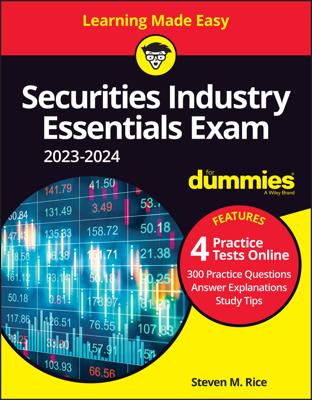Securities Industry Essentials Exam 2023-2024 For Dummies with Online Practice
Explore Book Buy On Amazon © Andrii Yalanskyi / Shutterstock.com
© Andrii Yalanskyi / Shutterstock.comRemembering bond terminology
The SIE exam designers expect you to know general bond terminology. This article reinforces the information you may have already learned from a prep course or study material (or are in the process of learning). This stuff is basic, but the SIE exam does test it:- Maturity date: All issued bonds have a stated maturity date (for example, 20 years, 30 years, and so on). The maturity date is the year bondholders get paid back for the loans they made. At maturity, bondholders receive par value (see the next bullet). Because not as many investors are looking to tie up their money for a long period of time, short-term bonds are more liquid (actively traded) than long-term bonds.
- Par value: Par value is the face value of the bond. Although par value isn’t significant to common stockholders (whose issuers use it solely for bookkeeping purposes), it’s important to bondholders. For SIE exam purposes, you can assume that the par value for each bond is $1,000 unless otherwise stated in the question.
Bond prices are quoted as a percentage of par value, often without the percent sign. A bond trading at 100 is trading at 100 percent of $1,000 par. Regardless of whether investors purchase a bond for $850 (85), $1,000 (100), or $1,050 (105), they’ll receive par value plus any interest due at the maturity date of the bond, usually with semi-annual interest payments along the way. Corporate bonds are usually quoted in increments of 1/8 percent (1/8% = 0.00125 or $1.25), so a corporate bond quoted at 99-3/8 (99.375 percent) would be trading at $993.75.
- Coupon rate: Of course, investors aren’t lending money to issuers for nothing; investors receive interest for providing loans to the issuer. The coupon rate on the bond tells the investors how much annual interest they’ll receive. Although bonds are no longer issued with physical coupons, previously, some bonds required investors to detach dated coupons (bearer bonds and partially registered bonds) from their bonds and turn them in to receive their interest payments.
The coupon rate is expressed as a percentage of par value. For example, a bond with a coupon rate of 6 percent would pay annual interest of $60 (6% @@ts $1,000 par value). You can assume that bonds pay interest semiannually unless otherwise stated. So, in this example, the investor would receive $30 every six months.
Bondholders receive interest (payment for the use of the money loaned), and stockholders receive dividends.
- The bond indenture: The indenture (also known as deed of trust or resolution) is the legal agreement between the issuer and its bondholders. It’s printed on or attached to the bond certificate. All indentures contain basic terms:
- The maturity date
- The par value
- The coupon rate (interest rate) and interest payment dates
- Any collateral securing the bond
- Any callable or convertible features
The bond indenture also includes the name of a trustee. A trustee is an organization that administers a bond issue for an institution. It ensures that the bond issuer meets all the terms and conditions associated with the borrowing. Essentially, the trustee tries to make sure that the issuer does the right thing.
Following bond issue and maturity schedules
Not only can bond certificates be in different forms, but they can also be scheduled with different types of maturities. Maturity schedules depend on the issuer’s needs. The following list presents an explanation of the types of bond issues and maturity schedules:- Term bonds: Term bonds are all issued at the same time and have the same maturity date. For example, if a company issues 20 million dollars’ worth of term bonds, they may all mature in 20 years. Because of the large payment that’s due at maturity, most corporations issuing this type of bond have a sinking fund. Most corporations issue term bonds because they lock in a coupon rate for a long period of time.
A corporation creates a sinking fund when it sets aside money over time in order to retire its debt. Investors like to see that a sinking fund is in place because it lowers the likelihood of default (the risk that the issuer can’t pay interest or par value back at maturity).
- Series bonds: These bonds are issued in successive years but have only one maturity date. Issuers of series bonds pay interest only on the bonds that they’ve issued so far. Construction companies that are building developments in several phases are most likely to issue this type of bond. There are less of these issued than term and serial bonds.
- Serial bonds: In this type of bond issue, a portion of the outstanding bonds mature at regular intervals (for example, 10 percent of the entire issue matures yearly). Serial bonds are usually issued by corporations and municipalities to fund projects that provide regular income streams. Most municipal (local government) bonds are issued with serial maturity.
A serial bond that has more bonds maturing on the final maturity date is called a balloon issue.
The SIE exam focuses mainly on term and serial bonds. A typical SIE exam question may ask, “Which of the following types of bonds is most likely to have a sinking fund?” Answer: Term bonds.
Secured and unsecured bonds
The assets of the issuer may or may not back bonds. For test purposes, assume that bonds backed by collateral (assets that the issuer owns) are considered safer for the investor. Secured bonds, or bonds backed by collateral, involve a pledge from the issuer that a specific asset (for instance, property) will be sold to pay off the outstanding debt in the event of default. Obviously, with all else being equal, secured bonds normally have a lower yield than unsecured bonds.The SIE exam tests your knowledge of several types of secured bonds:
- Mortgage bonds: These bonds are backed by property that the issuer owns. In the event of default or bankruptcy, the issuer must liquidate the property to pay off the outstanding bonds. Mortgage bonds may be open- or closed-end. With an open-end mortgage bond, the issuer may borrow more money using the same property as collateral. With a closed-end mortgage bond, the issuer cannot borrow more money using the same property as collateral.
- Equipment trusts: This type of bond is mainly issued by transportation companies and is backed by equipment they own (for instance, airplanes or trucks). If the company defaults on its bonds, it sells the assets backing the bonds to satisfy the debt.
- Collateral trusts: These bonds are backed by financial assets (stocks and bonds) that the issuer owns. A trustee (a financial institution the issuer hires) holds the assets and sells them to pay off the bonds in the event of default.
- Guaranteed bonds: Guaranteed bonds are backed by a firm other than the original issuer, usually a parent company. If the issuer defaults, the parent company pays off the bonds. As such, the rating of the bonds is tied to the rating of the guarantor.
- Debentures: These bonds are backed only by the issuer’s good word and written agreement (the indenture) stating that the issuer will pay the investor interest when due (usually semiannually) and par value at maturity.
- Income (adjustment) bonds: These bonds are the riskiest of all. The issuer promises to pay par value back at maturity and will make interest payments only if earnings are high enough. Companies in the process of reorganization usually issue these bonds at a deep discount (for example, the bonds sell for $500 and mature at par, or $1,000). For test purposes (and real-world purposes), you shouldn’t recommend these bonds to investors who can’t afford to take a lot of risk.
Because secured bonds are considered safer than unsecured bonds, secured bonds normally have lower coupon rates. You can assume that for the SIE, the more risk an investor takes, the more reward he will receive. Remember the saying “more risk equals more reward.” More reward may be in the form of a higher coupon rate or a lower purchase price. Either one — or both — lead to a higher yield for the investor.
When comparing short-term versus long-term debt securities, short-term bonds from the same issuer are considered safer because the investor is not tying up his money for as long a period of time. Because of the extra risk long-term bondholders are taking for tying up their money for a longer period of time, long-term bondholders generally (except in rare cases) receive a higher coupon (interest rate) for taking that additional risk.

